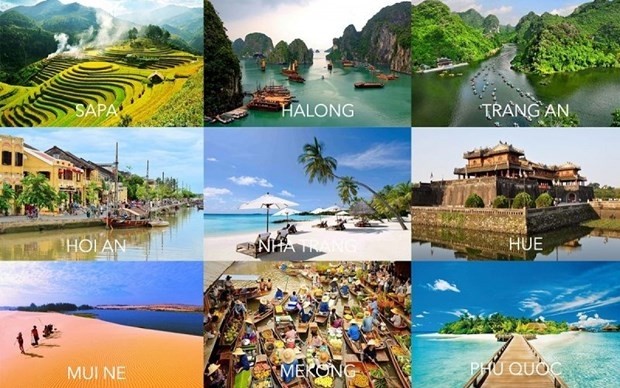 |
| Vietnam emerging as Southeast Asia's new tourist hot spot |
The article cited a report by Google Destination Insights which assessed that Vietnam was the 7th most searched destination from March to June this year, and the only country in Southeast Asia in the top 20.
Bobby Nguyen, Chairman of Rustic Hospitality Group, a tour agency, said that the boost is coming mainly from Chinese, Indian and Korean tourists. "China has reopened the outbound market to Vietnam and the Indian market has grown since 2022," he was quoted by the article.
Nguyen added that the use of social media and the influence of large travel groups have also helped promote Vietnam's international popularity.
The author also pointed to the Vietnamese Government’s new visa policy for international visitors arriving in the country, tripling visa waivers from 15 to 45 days for selected countries. The changes will come into force on August 15.
Gary Bowerman, a tourism analyst based in Kuala Lumpur, said the visa changes will boost the tourism sector. "It's picking up, and over the next six months, you will see travelers to Vietnam increase. I think it's going to be very strong, and you'll see growth particularly now the Chinese market is back," he said.
One of Vietnam's selling points is that it's a lesser-known destination, and it offers both tourism and business opportunities, said Bowerman.
91% of German businesses keen to expand investment in Vietnam
Approximately 91% of German businesses have expressed their keen interest in pouring further investment and expanding their operations in Vietnam, reported the Voice of Vietnam according to a survey recently conducted by the German Chamber of Commerce and Industry (DIHK).
Furthermore, 88% of respondents expressed their confidence in Vietnam’s business landscape, while nearly half of all enterprises questioned expected that the country’s economic growth would remain stable.
Elsewhere, some 21% of the surveyed firms believed that the Vietnamese economy would see significant improvements over the course of the year.
According to German businesses, thanks to the rapid implementation of the Government's action plans coupled with stable macroeconomic conditions, the country has maintained a positive economic growth rate, fueling German firms’ optimism about the economy’s positive outlook.
However, German investors remained cautious in the short term due to risks from global economic fluctuations such as low global demand (51%), concerns about economic development policy (46%), a general shortage of skilled workers (34%), and risk of supply chain disruption (28%).
They predicted that the Vietnamese economy would rebound in the medium term thanks to the EU-Vietnam Free Trade Agreements (EVFTA), the implementation of the "China Plus One" strategy, the global trend of diversifying production supply chains to highly competitive production centres in Southeast Asia, and green investment flows.
Meanwhile, 57% of German investors in Vietnam would like to prioritise diversifying their supply chains, and Vietnam is their top choice, along with Malaysia and Thailand.
To further enhance the attractiveness of Vietnamese investment environment, the German Chamber of Commerce and Industry in Vietnam (AHK Vietnam) proposed that the government deal with the shortage of skilled workforce, and take advantage of Industry 4.0 and digital transformation.
Moreover, the AHK also recommended prioritising the competitiveness of local suppliers in order to maintain their role in the global and German supply chains, while also complying with sustainability regulations such as Germany’s environmental, social, and governance (ESG) standards.
AHK Vietnam went on to propose a detailed roadmap for implementing the recently adopted Power Development Plan VIII to encourage renewable electricity production, along with simplifying and digitising administrative procedures as a way of maximising the benefits from the EVFTA and improving the local business climate.
Vietnam Airlines moves to increase flight frequency to the UK
National flag carrier Vietnam Airlines has increased the frequency of flights running between Vietnam and the UK since July to meet the increasing travel demand between the two countries, reported the Voice of Vietnam.
At present, the Hanoi-London route sees three flights fly per week, with aircraft departing on Tuesdays, Thursdays, and Sundays. Meanwhile, the carrier has increased the number of flights on the Ho Chi Minh City - London route to two per weeks on Fridays and Saturdays.
From October, the airline will increase the frequency of flights between Hanoi and Ho Chi Minh City to the UK to four and three weekday flights, respectively.
Phan The Thang, head of Vietnam Airlines' branch in the UK, said that since the first regular flight between the UK and Vietnam in January 25, 2022, after a gap of almost two years caused by the COVID-19 pandemic, the airline has served 111,000 passengers on the routes.
Thang also revealed in the first six months of this year, the airline witnessed a 5.5-fold increase in passenger transport revenue compared to the same period from last year.
With the operation of every-day flights to London starting from this winter, Vietnam Airlines hopes to soon achieve its pre-pandemic operation target, said Thang.
Vietnam Airlines’ first flight to the UK landed at Gatwick Airport on November 9, 2011, before its operations switched to Heathrow in 2015.
On December 1, 2015, Vietnam Airlines began using the Boeing 787 Dreamliner for its UK flights, becoming the first carrier in Southeast Asia to fly directly to Europe on this new aircraft.
Canned tuna exports to EU market edge up by 71%
Vietnam’s tuna exports to the European Union made significant breakthroughs during the opening five months of the year, with canned tuna products witnessing a sharp increase of 71% year on year, reported the Voice of Vietnam according to the Vietnam Association of Seafood Exporters and Producers (VASEP).
Most notably, tuna exports to the EU bounced back in May after enduring a decline in April, up 15% compared to the same period from last year.
Germany and the Netherlands were the two largest consumers of Vietnamese tuna throughout the reviewed period with respective increases of 23% and 26%.
Until the end of May, more than 31 enterprises had bene involved in exporting tuna to the EU market. Among them, FoodTech, Bidifisco, and Yueh Chyang Canned Food made up the three leading exporters that accounted for more than 40% of total tuna export turnover.
According to VASEP, due to the impact of inflation, high inventories, and rising prices of canned tuna, EU importers tend to increase their imports from nations with preferential tariffs, including Vietnam.
Truong Dinh Hoe, general secretary of VASEP, predicted that seafood exports, especially tuna exports to the EU market, would gradually recover ahead over the coming months thanks to rising demand during the festive season, along with other positive signs in the consumption markets.
Hoe noted the rebound in seafood consumption in May was a good signal for a general hike in aquatic exports during the year-end period.
Apart from these advantages, the VASEP leader advised enterprises to devise a proper marketing strategy in a bid to further boost aquatic exports to the EU market amid the global price of skipjack tuna not cooling down, along with making use of the preferential tariff quota that the EU has granted for Vietnamese canned tuna products under the Vietnam-EU Free Trade Agreement (EVFTA)./.





















































